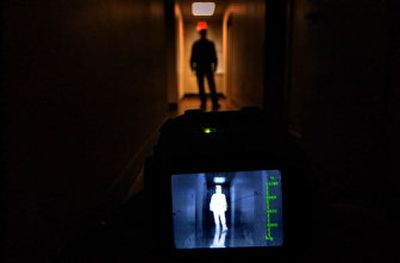Firefighters feel the heat, but see it too

When Spokane firefighters mopped up a recent south-side house fire, their eyes told them they had finished the job, as only black and charred remains were left. But an expensive thermal imaging camera told them otherwise. Armed with the infrared device, crew members saw hot spots under the destruction and were able to snuff out the smoldering remains.
The Spokane Fire Department has eight such devices to help with search-and-rescue operations, initial fire attacks and after-battle mop-up work.
The department purchased the infrared devices – which can cost more than $10,000 apiece – based on word-of-mouth and testing different models, said Deputy Fire Chief Dave Leavenworth.
“It can be time-consuming to do it,” said Anthony Hamins, of the fire research division at the National Institute of Standards and Technology. “Departments are (testing devices) in non-scientific ways. There are applied ways, but they’re not going to be able to test every application.”
Now, the Maryland-based institute, with the help of firefighters and product manufacturers, hopes to create compliance standards and fixed ratings for devices that detect heat signatures.
“Right now they only have manufacturer literature to rely on,” Hamins said. “And manufacturers don’t always highlight the faults of their products.”
That’s why Hamins and other fire researchers want to help crews out: so they know what some of the best products are, which are most cost-effective and what device will stand up to tough conditions.
Spokane has used the devices since 1997, and they have come a long way in terms of technology, Leavenworth said. First models were clunky and not always able to process images of immense heat.
“They would wash out and go completely white,” he said of the imagers’ displays, many of which are simply black and white – dark for colder temperatures and light for hot.
Now, the department has models that are one-third the size and have color displays. There are others with temperature indicators. So it’s understandable that it might be difficult to select the appropriate model for the job, Hamins said.
It could take years for standards to come out for the devices, Hamins said, but he would like the project to help first responders around the nation choose what type of technology they want when lives might be on the line.
They do pretty well even without standards, said Lt. Bob Shovald of the Coeur d’Alene Fire Department.
“Where we would normally have to tear out walls to look for fires, we no longer have to,” he said. “These things do it for us.”
Shovald said some manufacturers tout compliance ratings and industry standards for their products, but those have the potential to be gimmicks.
Leavenworth said compliance ratings might help departments ignore some models that might seem substandard on paper, but his crew would still test them in the field before making a purchase.
“I think it’s a character flaw of all firefighters,” he said. “You have to show me or I have to use the device to figure out which one I want.”
Crews should be comfortable with the equipment they use, so purchasing a device based only on a rating wouldn’t happen, he said, but “it would certainly cut down on the amount of units that you might have to process through your evaluation,”
Larry Rider, Spokane Valley Fire Department assistant chief, said some standards might be useful, but manufacturers should have some freedom.
“It just depends on what types of features you want,” he said. “Every generation is getting better.”
The Valley department has about a dozen units. Some of the newer ones, which are smaller units, cost between $7,000 and $8,000.
By standardizing the equipment, or giving ratings to products, Hamins also hopes to help lower the price of the technology – one of the largest complaints by first responders at a workshop he and other scientists conducted.
The national average for a unit, according to their research, is about $10,000 – about the price of some of the recent thermal imager purchases for the Spokane crew. In Coeur d’Alene, Shovald said, the three units they own cost between $15,000 and $18,000. All three departments have received several imagers through grants.
Standards might also help departments that don’t yet have the technology, Hamins said.
“All departments crave these things,” Hamins said. “Everybody wants to have their toys.”